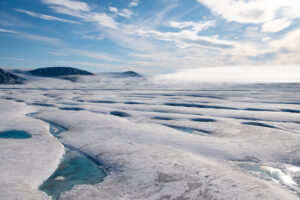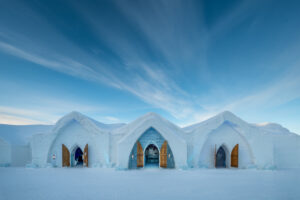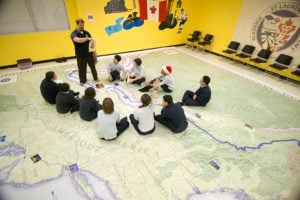
Environment
Last bastion of ice
What the collapse of the Milne ice shelf and the loss of a rare Arctic ecosystem might teach us about a changing planet
- 2894 words
- 12 minutes
This article is over 5 years old and may contain outdated information.
Science & Tech

Deep in the ancient ice of Antarctica, an array of sophisticated optical sensors is helping answer one of the greatest mysteries of our time: what is producing the cosmic rays that bombard our planet with intense high-energy radiation?
IceCube — occupying one cubic kilometre of the ice sheet at the South Pole — is the world’s largest neutrino detector. It’s recording the presence of high-energy neutrinos, sub-atomic particles born in the unimaginable fury of cataclysmic astrophysical events.
Neutrino research is revolutionizing the way we look at the cosmos, according to particle physicist Darren Grant of the University of Alberta, who is part of IceCube’s international team.
“Neutrinos are quite possibly the ideal messenger for information about the fundamental nature of the universe,” says Grant. “They can pass through anything, and unlike protons, which change direction from magnetic fields they encounter along the way, or light, which gets absorbed, neutrinos arrive on Earth with their direction and energy unchanged.”
But they’re also highly elusive. A neutrino can only be detected on the rare occasion when it interacts with another particle. “Every second,” explains Grant, “ten billion neutrinos pass through your thumb, but you’ll be 80 before a single one might interact with your body.” This makes studying neutrinos painstakingly slow: it took eight decades of research to find out that they have mass.
IceCube is an ideal neutrino receptor partly because of its enormous size, which boosts the chances of detecting neutrinos — it offers more atoms with which they can react — and also because of the unique properties of the Antarctic ice itself.
When a high-energy neutrino interacts with the ice, a charged “partner particle” is produced that releases energy in a flash of blue light. Deep Antarctic ice — at the South Pole it’s nearly three kilometres thick — is optically very clear, allowing IceCube’s sensors to pick up a flash 200 metres away. As well, the ice is almost entirely free from ambient radioactivity that could interfere with detecting neutrinos. Finally, a neutrino observatory needs to be in a very deep location, to screen out surface radiation from cosmic rays. Complex and expensive to construct in deep mines, this is simple in ice: researchers simply melt a hole and insert the sensors, and the hole refreezes. As Grant points out, “it’s much easier to melt ice than move rock.”
The results of the neutrino research at IceCube are exciting, says Grant. “We’ve discovered the first very high-energy neutrinos — higher energy than ever detected before — coming from something outside the solar system. We’re building a sky map of the origin of these neutrinos to point back to their potential sources. The next step is to match these to astrophysical events such as supernovae and gamma bursts. When you can identify the sources of high-energy events you can start to understand how processes work.”
Through its crystalline window of ice at the bottom of the world, IceCube is revealing new clues — one flash of blue light at a time — that are dramatically improving our knowledge of the universe.


Are you passionate about Canadian geography?
You can support Canadian Geographic in 3 ways:

Environment
What the collapse of the Milne ice shelf and the loss of a rare Arctic ecosystem might teach us about a changing planet

Travel
An unforgettable Nordic-inspired experience where ice and snow are transformed into an enchanting overnight stay

Kids
Canadian Geographic Education’s series of giant floor maps gives students a colossal dose of cartography and is a powerful teaching tool

Environment
In his new book, Klaus Dodds delves into the fascinating natural and cultural history of ice